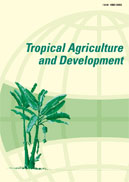All issues

Volume 52 (2008)
- Issue 4 Pages 89-
- Issue 3 Pages 63-
- Issue 2 Pages 37-
- Issue 1 Pages 1-
Predecessor
Volume 52, Issue 3
Displaying 1-4 of 4 articles from this issue
- |<
- <
- 1
- >
- >|
Original Article
-
Kaihei KOSHIO, Teppei OSAKA, Kenji IRIE, Hidekazu TOYOHARA, Fumio KIKU ...2008Volume 52Issue 3 Pages 63-68
Published: 2008
Released on J-STAGE: July 27, 2009
JOURNAL FREE ACCESSTolerance to lodging is an essential trait for rice direct sowing cultivation. Effective use of semidwarfing alleles at the sd-1 locus is considered to be promising to breed high-yielding and lodging-tolerant cultivars for direct sowing. The semidwarfism of the sd-1 alleles, however, might exert adverse effects on the emergence and establishment of rice seedlings. In the present study, investigations were carried out to determine whether semidwarfism exerted adverse effects on seedling emergence and establishment under direct sowing conditions by using isolines harboring semidwarfing alleles derived from three different donor parents, Shiranui, Reimei and Taichung Native 1. It was eventually demonstrated that the semidwarfing alleles did not exert adverse effects on emergence and establishment of rice seedlings.View full abstractDownload PDF (505K) -
Orwintinee CHUSRI, Naoko KOZAI, Tatsushi OGATA, Hirokazu HIGUCHI, Yosh ...2008Volume 52Issue 3 Pages 69-73
Published: 2008
Released on J-STAGE: July 27, 2009
JOURNAL FREE ACCESSAttempts were made to apply Paclobutrazol (PBZ) to 3-year-old ‘Irwin’ mango trees in order to alleviate the sparse flowering of ‘Irwin’ for fruit production in Okinawa under plastic house conditions. The study was conducted in Ishigaki, Okinawa Prefecture. Two flushes were observed after pruning in May 2006, and PBZ was applied in July of that year when the leaves were expanding after the second flush. On July 1, PBZ was applied to soil by drenching at a rate of 1 g a.i. per tree, or as a foliar spray at the rate of 1500 ppm. In the PBZ-treated trees, bud break occurred 18-22 days earlier than in the control trees. Apical bud breaking exceeded 98% in the PBZ-treated trees compared with only 42% in the control trees. More than 96% of the PBZ-treated trees produced floral shoots, compared with only 35% of the control trees. The panicles of the PBZ-treated trees, were shorter than those of the control trees. Fruit yield per tree was higher in the PBZ-treated trees than in the control trees. The Brix value and titratable acidity of the fruits did not differ among the treatments.View full abstractDownload PDF (701K) -
Takashi MASUNO, Kazunobu IKEYA2008Volume 52Issue 3 Pages 74-81
Published: 2008
Released on J-STAGE: July 27, 2009
JOURNAL FREE ACCESSThe purpose of the present study was to analyze the changes in the location of shifting cultivation fields, mainly of upland rice fields, in northern Thailand. Practically, the authors examined the land use history of two households in a Yao (Mien) community from 1980 to 2005. Rotational use, in which the same field is reused at an interval of several years, was confirmed in nine cases based on the annual changes in the location of upland rice fields. The duration of the average fallow period was similar for both households, namely, 5.0 years and 4.5 years after the late 1980s. The actual fallow period was highly variable, however, depending on the fields. A distribution of 1-10 years and 1-13 years was apparent in the fallow period for each household. The time when each household stopped using the fallow system differed depending on the strips of field, and the year when this first occurred was 1995 for one household and 1999 for the other. Our results underscored the variety of the processes involved during the transition from the shifting cultivation system to the permanent system for field cultivation or forestry, depending on both households and strips of field.View full abstractDownload PDF (820K) -
Piyanath PAGAMAS, Eiji NAWATA2008Volume 52Issue 3 Pages 82-87
Published: 2008
Released on J-STAGE: July 27, 2009
JOURNAL FREE ACCESSThe effects of elevated flower and pod temperatures (38/22°C, DH; 30/30°C, NH; and 38/30°C, DNH, day and night temperatures, respectively) and whole plant heat stress (38/30°C, WH) after anthesis on fruit development and seed quality of chili pepper (Capsicum annuum L. var. Shishito) were investigated, compared with the control temperature (30/22°C). The highest values of fruit width, length and weight were observed at control conditions. The high temperature treatments significantly decreased fruit growth and development. DH, NH, DNH and WH reduced the growth period of ‘Shishito’ fruits by 5, 10, 10 and 15 days, respectively. Subjecting the fruit and whole plant to high temperatures adversely affected the seed set and increased the proportion of abnormal seeds per fruit. Partial heat treatments applied to the fruits decreased the carbohydrate content and reduced the germination rates and vigor of the seeds, and the most pronounced adverse effects were observed in the WH treatment. The results indicated that high fruit temperature exerted direct adverse effects on seed formation and sink strength of the seeds in ‘Shishito’ pepper. Inhibition of the assimilate supply from source organs caused by both the suppression of the sink strength and source productivity may be the major effect of heat stress on the reduction of seed quality.View full abstractDownload PDF (938K)
- |<
- <
- 1
- >
- >|